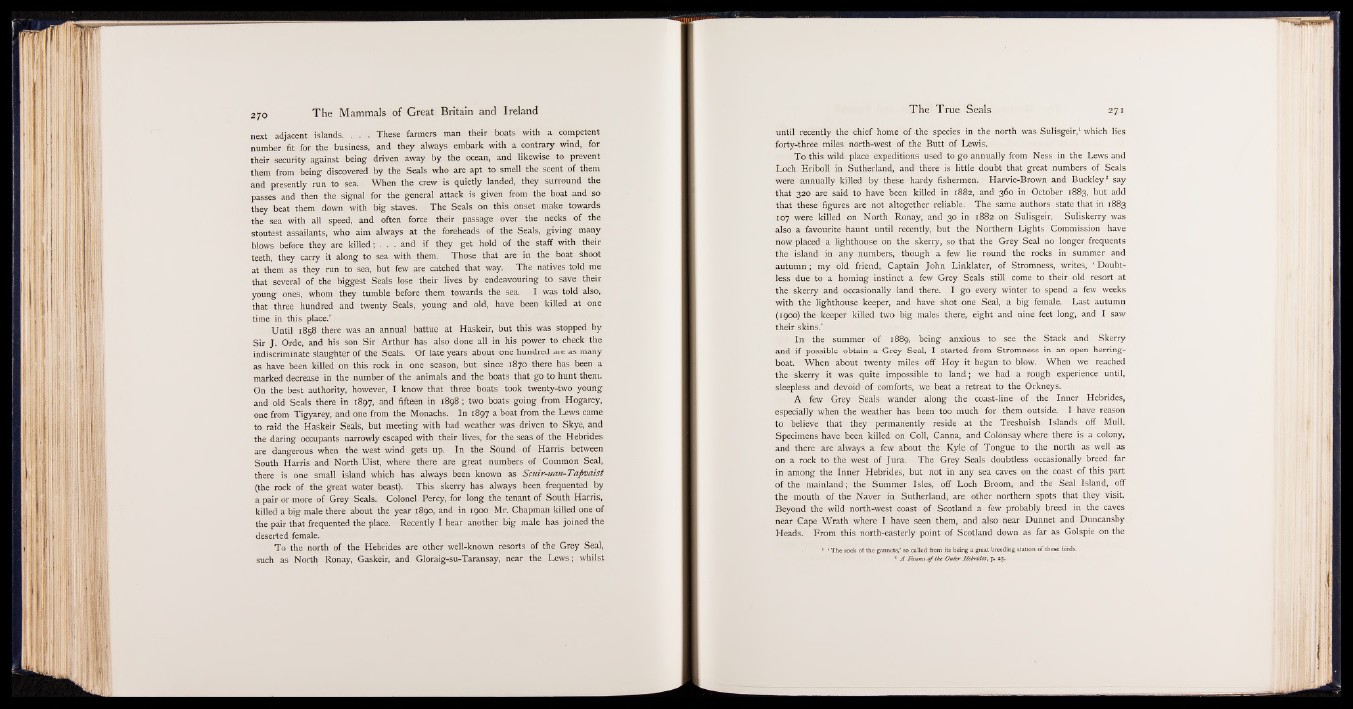
next adjacent islands. . . . These farmers man their boats with a competent
number fit for the business, and they always embark with a contrary wind, for
their security against being driven away by the ocean, and likewise to prevent
them from being discovered by the Seals who are apt to smell the scent of them
and presently run to sea. When the crew is quietly landed, they surround the
passes and then the signal for the general attack is given from the boat and so
they beat them down with big staves. The Seals on this onset make towards
the sea with all speed, and often force their passage over the necks of the
stoutest assailants, who aim always at the foreheads of the Seals, giving many
blows before they are killed; . . . and if they get hold of the staff with their
teeth, they carry it along to sea with them. Those that are in the boat shoot
at them as they run to sea, but few are catched that way. The natives told me
that several of the biggest Seals lose their lives by endeavouring to save their
young ones, whom they tumble before them towards the sea. I was told also,
that three hundred and twenty Seals, young and old, have been killed at one
time in this place.’
Until 1858 there was an annual battue at Haskeir, but this was stopped by
Sir J. Orde, and his son Sir Arthur has also done all in his power to check the
indiscriminate slaughter of the Seals. Of late years about one hundred are as many
as have been killed on this rock in one season, but since 1870 there has been a
marked decrease in the number of the animals and the boats that go to hunt them.
On the best authority, however, I know that three boats took twenty-two young
and old Seals there in 1897, and fifteen in 1898; two boats going from Hogarey,
one from Tigyarey, and one from the Monachs. In 1897 a boat from the Lews came
to raid the Haskeir Seals, but meeting with bad weather was driven to Skye, and
the daring occupants narrowly escaped with their lives, for the seas of the Hebrides
are dangerous when the west wind gets up. In the Sound of Harris between
South Harris and North Uist, where there are great numbers of Common Seal,
there is one small island which has always been known as Scuir-nan~Tapvaist
(the rock of the great water beast). This skerry has always been frequented by
a pair or more of Grey Seals. Colonel Percy, for long the tenant of South Harris,
killed a big male there about the year 1890, and in 1900 Mr. Chapman killed one of
the pair that frequented the place. Recently I hear another big male has joined the
deserted female.
To the north of the Hebrides are other well-known resorts of the Grey Seal,
such as North Ronay, Gaskeir, and Gloraig-su-Taransay, near the Lews; whilst
until recently the chief home of the species in the north was Sulisgeir,1 which lies
forty-three miles north-west of the Butt of Lewis.
To this wild place expeditions used to go annually from Ness in the Lews and
Loch Eriboll in Sutherland, and there is little doubt that great numbers of Seals
were annually killed by these hardy fishermen. Harvie-Brown and Buckley2 say
that 320 are said to have been killed in 1882, and 360 in October 1883, but add
that these figures are not altogether reliable. The same authors state that in 1883
107 were killed on North Ronay, and 30 in 1882 on Sulisgeir. Suliskerry was
also a favourite haunt until recently, but the Northern Lights Commission have
now placed a lighthouse on the skerry, so that the Grey Seal no longer frequents
the island in any numbers, though a few lie round the rocks in summer and
autumn; my old friend, Captain John Linklater, of Stromness, writes, * Doubtless
due to a homing instinct a few Grey Seals still come to their old resort at
the skerry and occasionally land there. I go every winter to spend a few weeks
with the lighthouse keeper, and have shot one Seal, a big female. Last autumn
(1900) the keeper killed two big males there, eight and nine feet long, and I saw
their skins.’
In the summer of 1889, being anxious to see the Stack and Skerry
and if possible obtain a Grey Seal, I started from Stromness in an open herring-
boat. When about twenty miles off Hoy it began to blow. When we reached
the skerry it was quite impossible to land; we had a rough experience until,
sleepless and devoid of comforts, we beat a retreat to the Orkneys.
A few Grey Seals wander along the coast-line of the Inner Hebrides,
especially when the weather has been too much for them outside. I have reason
to believe that they permanently reside at the Treshnish Islands off Mul||
Specimens have been killed on Coll, Canna, and Colonsay where there is a colony,
and there are always a few about the Kyle of Tongue to the north as well as
on a rock to the west of Jura. The Grey Seals doubtless occasionally breed far
in among the Inner Hebrides, but not in any sea caves on the coast of this part
of the mainland; the Summer Isles, off Loch Broom, and the Seal Island, off
the mouth of the Naver in Sutherland, are other northern spots that they visit.
Beyond the wild north-west coast of Scotland a few probably breed in the caves
near Cape Wrath where I have seen them, and also near Dunnet and Duncansby
Heads. From this north-easterly point of Scotland down as far as Golspie on the
1 ‘ The rock of the gannets,’ so called from its being a great breeding station of these birds.
9 A Fauna o f the Outer Hebrides, p. *5.